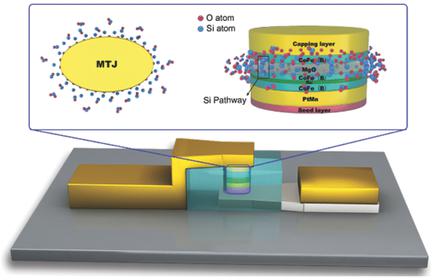当前位置:
X-MOL 学术
›
Adv. Electron. Mater.
›
论文详情
Our official English website, www.x-mol.net, welcomes your
feedback! (Note: you will need to create a separate account there.)
Heterogeneous Memristive Devices Enabled by Magnetic Tunnel Junction Nanopillars Surrounded by Resistive Silicon Switches
Advanced Electronic Materials ( IF 5.3 ) Pub Date : 2018-01-03 , DOI: 10.1002/aelm.201700461 Yu Zhang 1, 2 , Xiaoyang Lin 1 , Jean-Paul Adam 2 , Guillaume Agnus 2 , Wang Kang 1 , Wenlong Cai 1 , Jean-Rene Coudevylle 2 , Nathalie Isac 2 , Jianlei Yang 1 , Huaiwen Yang 1 , Kaihua Cao 1, 3 , Hushan Cui 1, 3 , Deming Zhang 1 , Youguang Zhang 1 , Chao Zhao 1, 3 , Weisheng Zhao 1 , Dafine Ravelosona 2
Advanced Electronic Materials ( IF 5.3 ) Pub Date : 2018-01-03 , DOI: 10.1002/aelm.201700461 Yu Zhang 1, 2 , Xiaoyang Lin 1 , Jean-Paul Adam 2 , Guillaume Agnus 2 , Wang Kang 1 , Wenlong Cai 1 , Jean-Rene Coudevylle 2 , Nathalie Isac 2 , Jianlei Yang 1 , Huaiwen Yang 1 , Kaihua Cao 1, 3 , Hushan Cui 1, 3 , Deming Zhang 1 , Youguang Zhang 1 , Chao Zhao 1, 3 , Weisheng Zhao 1 , Dafine Ravelosona 2
Affiliation

|
Emerging nonvolatile memories (NVMs) have currently attracted great interest for their potential applications in advanced low‐power information storage and processing technologies. Conventional NVMs, such as magnetic random access memory and resistive random access memory, suffer from limitations of low tunnel magnetoresistance, low access speed, or finite endurance. NVMs with synergetic advantages are still highly desired for future computer architectures. This study reports a heterogeneous memristive device composed of a magnetic tunnel junction (MTJ) nanopillar surrounded by resistive silicon switches, named resistively enhanced MTJ (Re‐MTJ), which may be utilized for novel memristive memories, enabling new functionalities that are inaccessible for conventional NVMs. The Re‐MTJ device features a high ON/OFF ratio of >1000% and multilevel resistance behavior by combining magnetic switching together with resistive switching mechanisms. The magnetic switching originates from the MTJ, while the resistive switching is induced by a point‐switching filament process that is related to the mobile oxygen ions. Microscopic evidence of silicon aggregated as nanocrystals along the edges of the nanopillars verifies the synergetic mechanism of the heterogeneous memristive device. This device may provide new possibilities for advanced memristive memory and computing architectures, e.g., in‐memory computing and neuromorphics.
中文翻译:

磁隧道结纳米柱围绕电阻式硅开关实现的异质忆阻器件
当前,新兴的非易失性存储器(NVM)在高级低功耗信息存储和处理技术中的潜在应用引起了人们极大的兴趣。常规的NVM,例如磁性随机存取存储器和电阻性随机存取存储器,受到隧道磁阻低,存取速度低或有限耐久性的限制。具有协同优势的NVM对于未来的计算机体系结构仍然非常需要。这项研究报告了一种由磁隧道结(MTJ)纳米柱和电阻性硅开关围绕的异质忆阻器件,称为电阻增强型MTJ(Re-MTJ),可用于新型忆阻存储器,从而实现常规无法使用的新功能NVM。Re-MTJ设备具有高的开/关比,> 通过将磁性开关与电阻开关机制结合在一起,可实现1000%的多级电阻性能。磁开关起源于MTJ,而电阻开关则是由与移动氧离子有关的点开关灯丝过程引起的。沿着纳米柱的边缘聚集为纳米晶体的硅的微观证据证明了异质忆阻器件的协同机制。该设备可能为先进的忆阻存储器和计算架构(例如,内存计算和神经形态学)提供新的可能性。电阻切换是由与移动氧离子有关的点切换灯丝过程引起的。沿着纳米柱的边缘聚集为纳米晶体的硅的微观证据证明了异质忆阻器件的协同机制。该设备可能为先进的忆阻存储器和计算架构(例如,内存计算和神经形态学)提供新的可能性。电阻切换是由与移动氧离子有关的点切换灯丝过程引起的。沿着纳米柱的边缘聚集为纳米晶体的硅的微观证据证明了异质忆阻器件的协同机制。该设备可能为先进的忆阻存储器和计算架构(例如,内存计算和神经形态学)提供新的可能性。
更新日期:2018-01-03
中文翻译:

磁隧道结纳米柱围绕电阻式硅开关实现的异质忆阻器件
当前,新兴的非易失性存储器(NVM)在高级低功耗信息存储和处理技术中的潜在应用引起了人们极大的兴趣。常规的NVM,例如磁性随机存取存储器和电阻性随机存取存储器,受到隧道磁阻低,存取速度低或有限耐久性的限制。具有协同优势的NVM对于未来的计算机体系结构仍然非常需要。这项研究报告了一种由磁隧道结(MTJ)纳米柱和电阻性硅开关围绕的异质忆阻器件,称为电阻增强型MTJ(Re-MTJ),可用于新型忆阻存储器,从而实现常规无法使用的新功能NVM。Re-MTJ设备具有高的开/关比,> 通过将磁性开关与电阻开关机制结合在一起,可实现1000%的多级电阻性能。磁开关起源于MTJ,而电阻开关则是由与移动氧离子有关的点开关灯丝过程引起的。沿着纳米柱的边缘聚集为纳米晶体的硅的微观证据证明了异质忆阻器件的协同机制。该设备可能为先进的忆阻存储器和计算架构(例如,内存计算和神经形态学)提供新的可能性。电阻切换是由与移动氧离子有关的点切换灯丝过程引起的。沿着纳米柱的边缘聚集为纳米晶体的硅的微观证据证明了异质忆阻器件的协同机制。该设备可能为先进的忆阻存储器和计算架构(例如,内存计算和神经形态学)提供新的可能性。电阻切换是由与移动氧离子有关的点切换灯丝过程引起的。沿着纳米柱的边缘聚集为纳米晶体的硅的微观证据证明了异质忆阻器件的协同机制。该设备可能为先进的忆阻存储器和计算架构(例如,内存计算和神经形态学)提供新的可能性。











































 京公网安备 11010802027423号
京公网安备 11010802027423号